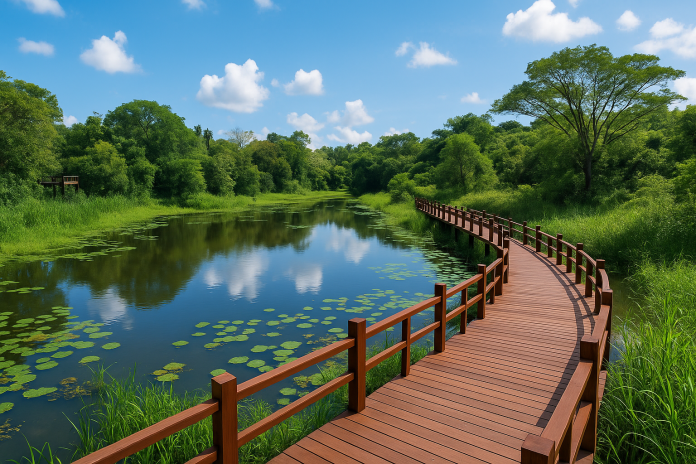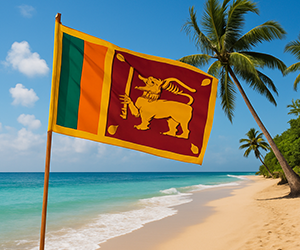Introduction
In the heart of bustling Colombo, where skyscrapers and highways dominate the skyline, lies a serene green haven few expect to find—Baddegana Wetland Park. Located just a few kilometers from the city center, this tranquil oasis showcases Sri Lanka’s rich biodiversity, unique wetland ecosystems, and sustainable conservation efforts.
Baddegana Wetland Park is not only a refuge for wildlife and migratory birds but also a space for nature lovers, photographers, and urban dwellers to reconnect with the natural world. This comprehensive article explores everything you need to know about Baddegana Wetland Park, including its history, ecology, visitor experience, and conservation importance.
Overview of Baddegana Wetland Park
- Location: Baddegana Road, Sri Jayawardenepura Kotte (capital area of Sri Lanka)
- Total Area: 18 hectares
- Managed by: Colombo Wetland Management Project under the Sri Lanka Land Reclamation and Development Corporation
- Main Features: Elevated walkways, birdwatching towers, butterfly gardens, and educational exhibits
Why It Matters
Wetlands are critical for climate resilience, biodiversity conservation, and urban sustainability. Baddegana Wetland Park serves as a prime example of how urban areas can protect green spaces while offering residents a place for relaxation, learning, and eco-tourism.
A Brief History of the Park
Originally a neglected and flood-prone swamp, this area was transformed as part of the Metro Colombo Urban Development Project with the aim of:
- Reducing flood risks in Colombo
- Conserving biodiversity
- Enhancing eco-tourism
- Educating the public on wetland ecosystems
Since its opening to the public in 2016, Baddegana Wetland Park has received praise for blending conservation with accessibility, earning it a spot among Sri Lanka’s top urban green zones.
Ecosystem and Biodiversity
A Wetland Wonderland
Wetlands are transitional zones between land and water. Baddegana Wetland Park includes:
- Marshlands
- Swamps
- Lakes and ponds
- Floodplains
- Mangroves and reed beds
These habitats provide breeding and feeding grounds for many species while helping to filter pollutants from urban runoff.
Flora at Baddegana Wetland Park
The park is home to over 200 species of plants, many of which are native or endemic to Sri Lanka, including:
- Lotus and water lilies
- Mangrove shrubs
- Marsh grasses and reeds
- Medicinal herbs
The park also features curated sections like butterfly gardens and medicinal plant zones, enhancing biodiversity and educational value.
Fauna and Wildlife
Baddegana Wetland Park is a birdwatcher’s paradise and supports:
- 80+ bird species, including migratory waterfowl
- Monkeys, water monitors, and squirrels
- Butterflies, dragonflies, and rare amphibians
- Endemic reptiles like the Sri Lankan krait
Notable bird sightings include:
- Purple heron
- Common kingfisher
- Spot-billed pelican
- White-breasted waterhen
Birdwatching at Baddegana Wetland Park
With multiple bird hides and towers, the park is designed to provide birdwatchers and wildlife photographers the best vantage points without disturbing the natural habitat.
Best Time for Birdwatching
- Early mornings (6:00–8:00 am) and late afternoons (4:00–6:00 pm)
- Migratory season: October to March
Visitors are encouraged to bring binoculars, long lenses, and wear neutral colors for minimal disturbance to wildlife.
Eco-Tourism and Visitor Experience
Facilities and Attractions
- Elevated wooden walkways for guided trails
- Observation decks and towers
- Educational signage and maps
- Rest areas and picnic spots
- Guided tours and workshops
- Nature interpretation center
Activities You Can Enjoy
- Birdwatching
- Nature photography
- Butterfly watching
- Leisure walks and jogging
- Educational visits for schools
- Eco-camps and conservation workshops
Entry Details
- Opening hours: 6:00 AM – 6:00 PM daily
- Entry fee: Minimal and affordable
- Wheelchair accessible: Yes
- Parking available: Yes
Sustainability and Conservation Efforts
Baddegana Wetland Park is more than a tourist attraction—it’s a living laboratory for sustainability.
Ecosystem Services
- Flood mitigation: Wetlands act as natural water reservoirs
- Air purification: Wetland plants help improve air quality
- Carbon sequestration: Mitigates effects of climate change
- Urban heat reduction: Maintains cooler local microclimate
Community Engagement
The park promotes awareness by engaging:
- Local schools and universities
- Conservation groups and NGOs
- Corporate CSR activities
Workshops on bird identification, native plant cultivation, and plastic waste reduction are regularly held to involve the public in protecting this fragile ecosystem.
Accessibility and How to Get There
From Colombo
- By car: 25–30 minutes from Colombo Fort via Parliament Road
- Public transport: Buses heading to Sri Jayawardenepura Kotte, then a short tuk-tuk ride
- Cycling paths: Available for eco-conscious travelers
Nearby Attractions
You can combine your visit with:
- Diyatha Uyana Park
- Parliament Grounds
- Kotte Rajamaha Viharaya
- Sri Jayawardenepura Bird Sanctuary
Tips for Visiting Baddegana Wetland Park
- Bring binoculars and a camera with zoom lens
- Wear comfortable shoes and light-colored clothing
- Carry water bottles and mosquito repellent
- Avoid plastic waste—bring reusable containers
- Respect the rules: No loud music, feeding animals, or littering
Ideal Time to Visit
- Best season: December to April (dry and pleasant)
- Avoid monsoon months: May to September (can flood trails)
- Bird season: Migratory birds peak between October and March
Morning and evening visits offer the best lighting and coolest weather for exploration.
Photography and Nature Lovers’ Paradise
Baddegana Wetland Park offers spectacular landscapes with opportunities to capture:
- Misty marshes at sunrise
- Reflections in still waters
- Close-up wildlife photography
- Patterns of reeds and lotuses
- Macro shots of butterflies and insects
Whether you’re a travel blogger, Instagrammer, or professional nature photographer, the park offers a canvas of natural beauty.
Challenges and the Way Forward
Like many urban green spaces, Baddegana Wetland Park faces challenges:
- Encroachment by real estate and construction
- Pollution from upstream areas
- Visitor misbehavior and littering
- Climate change and irregular rainfall patterns
However, strong collaborations between government bodies, local communities, and international conservationists are ensuring that the park not only survives but thrives.
Future plans include:
- Expanding the wetland buffer zone
- Introducing solar-powered lighting and eco-toilets
- Launching citizen science initiatives and mobile apps for species tracking
Educational and Research Opportunities
Universities and environmental NGOs use Baddegana Wetland Park as a field study site. Topics researched here include:
- Urban wetland biodiversity
- Wetland soil and water chemistry
- Impact of urbanization on ecosystems
- Community-led conservation strategies
If you’re an educator or student, this is a fantastic spot for nature-based learning and research projects.
Conclusion
Baddegana Wetland Park in Sri Lanka stands as a shining example of how nature and urban development can coexist harmoniously. It’s not just a park—it’s a sanctuary, a classroom, and a symbol of sustainability.
In a rapidly urbanizing country, the protection and promotion of urban wetlands like Baddegana are crucial for both the environment and society. Whether you are a local nature enthusiast, an eco-tourist, a student, or a family looking for a peaceful weekend escape, Baddegana Wetland Park welcomes you with open arms—and the soothing sounds of rustling reeds and bird songs.
So next time you’re in Colombo or Kotte, make sure to set aside time to explore this hidden gem of Sri Lanka’s eco-heritage. You’ll leave not only with beautiful photos but with a deeper understanding of how nature sustains life—even in the heart of a city.




